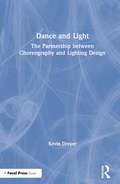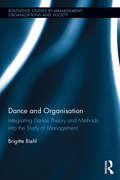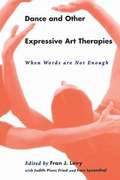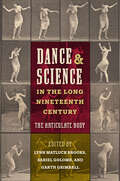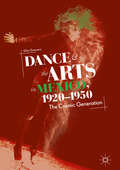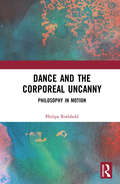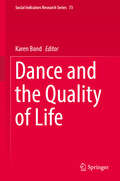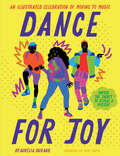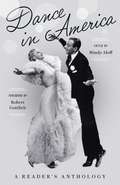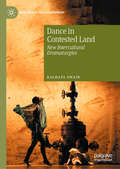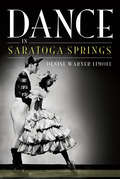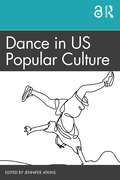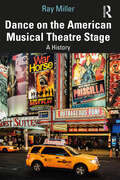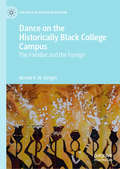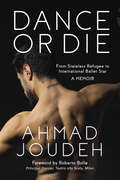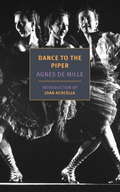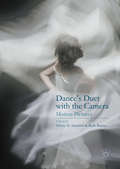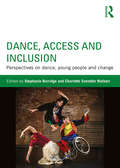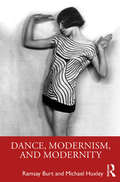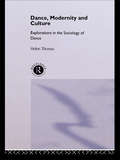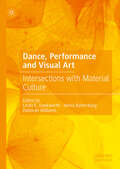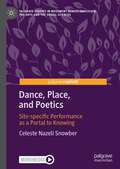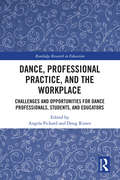- Table View
- List View
Dance and Light: The Partnership Between Choreography and Lighting Design
by Kevin DreyerDance and Light examines the interconnected relationship between movement and design, the fluid partnership that exists between the two disciplines, and the approaches that designers can take to enhance dance performances through lighting design. The book demystifies lighting for the dancer and helps designers understand how the dancer/choreographer thinks about their art form, providing insight into the choreographer’s process and exploring how designers can make the most of their resources. The author shares anecdotes and ideas from an almost 50-year career as a lighting designer, along with practical examples and insights from colleagues, and stresses the importance of clear communication between designers, choreographers, and dancers. Attention is also given to the choreographer who wants to learn what light can do to help enhance their work on stage. Written in short, stand-alone chapters that allow readers to quickly navigate to areas of interest, Dance and Light is a valuable resource for lighting design classes wishing to add a section on dance lighting, as well as for choreography classes who want to better equip young artists for a significant collaborative partnership.
Dance and Organization: Integrating Dance Theory and Methods into the Study of Management (Routledge Studies in Management, Organizations and Society)
by Brigitte BiehlDance and Organisation is the first comprehensive work to integrate dance theory and methods into the study of management, which have developed an interest in the arts and the humanities. Dance represents dynamics and change and puts the moving body at the centre, which has been ignored and oppressed by traditional management theory. ‘Being’ a leader however also means to ‘move’ like one, and critical lessons can be learned from ballerinas and modern dancers. Leadership is a dialogue, as in the work of musicians, conductors and DJs who manage groups without words. Movement in organisational space, in a museum or a techno club can be understood as a choreography and site-specific performance. Movement also is practically used for leadership and employee development workshops and can be deployed as an organisational research method. By taking a firm interdisciplinary stance in dance studies and organisational research to explore management topics, reflecting on practitioner accounts and research projects, the book seeks to make an innovative contribution to our understanding of the moving body, generating new insights on teamwork, leadership, gender in management, organisational space, training and research methods. It comprises an important contribution to the organizational behaviour and critical management studies disciplines, and looks to push the boundaries of the academic literature.
Dance and Other Expressive Art Therapies: When Words are Not Enough
by Fran J. Levy<p>The field of dance/movement therapy has long awaited a book, such as this one, which gives us detailed clinical material on specific patient populations. Fran Levy's first book, Dance/Movement Therapy: A Healing Art, provided a strong practical, historical, and theoretical foundation on which this book firmly stands. All of the selections that follow have been written by recognized leaders and contributors to the field. <p>Expressed in language that appeals to the heart as well as the mind, the book addresses immediate and pressing clinical concerns. Technical jargon is kept to a minimum, and, when used, is always defined. Throughout the book, the needs of patients are carefully considered and creatively met through the courage and perseverance of each therapist. Thoughtful and sensitive descriptions of the individuals discussed allows for an unusual intimacy between the reader and the patient. The authors believe that the experience of movement, on both symbolic and expressive levels, can transform individuals and guide their journeys to recovery.</p>
Dance and Science in the Long Nineteenth Century: The Articulate Body
by Lynn Matluck Brooks Sariel Golomb Garth GrimballRevealing the interplay and influence of dance and science during an age of colonial expansion Bringing together dance and science, two paradigms that explore the nature and possibilities of the body, this volume illuminates the meanings and articulations of dance in nineteenth-century societies. This global collection of studies reveals how the two fields informed each other’s development and engaged with dominant European worldviews in a time of unprecedented colonial expansion. The chapters in Dance and Science in the Long Nineteenth Century examine how trends and developments in the performing arts reflected scientific thinking of this era, including the categorization of “types” of bodies and the ranking of cultural and religious beliefs, as well as how dance served as an active site of inquiry where the workings and limits of the human body could be studied. Researchers discuss topics including the influence of plant biology on the aesthetics of ballet, technological advancements in the staging and recording of performances, arguments for the use of Eurhythmics in promoting a stronger “race,” and European fascination with Indian dance and yoga. Featuring response essays that put leading scholars in conversation with one another and offer new perspectives, this volume is unique in its geographic scope and its discussion of diverse bodies, cultures, themes, and scientific disciplines. It sheds light on a historical interplay that has shaped many of today’s political and cultural realities.Contributors: Johanna Pitetti-Heil | Chantal Frankenbach | Jane Desmond | Christian Ducomb | Claudia Jeschke | Kélina Gotman | Pallabi Chakravorty | Andrea Harris | Dick McCaw | Stephen Ha | Emily Coates | Tiziana Leucci | Elizabeth Claire | Susan Cook | Carrie Streeter | Olivia Sabee | Janice Ross | Alexander H. Schwan | Whitney Laemmli
Dance and the Arts in Mexico, 1920-1950: The Cosmic Generation
by Ellie GuerreroDance and the Arts in Mexico, 1920–1950 tells the story of the arts explosion that launched at the end of the Mexican revolution, when composers, choreographers, and muralists had produced state-sponsored works in wide public spaces. The book assesses how the “cosmic generation” in Mexico connected the nation-body and the dancer’s body in artistic movements between 1920 and 1950. It first discusses the role of dance in particular, the convergences of composers and visual artists in dance productions, and the allegorical relationship between the dancer's body and the nation-body in state-sponsored performances. The arts were of critical import in times of political and social transition, and the dynamic between the dancer’s body and the national body shifted as the government stance had also shifted. Second, this book examines more deeply the involvement of US artists and patrons in this Mexican arts movement during the period. Given the power imbalance between north and south, these exchanges were vexed. Still, the results for both parties were invaluable. Ultimately, this book argues in favor of the benefits that artists on both sides of the border received from these exchanges.
Dance and the Corporeal Uncanny: Philosophy in Motion
by Philipa RothfieldDance and the Corporeal Uncanny takes the philosophy of the body into the field of dance, through the lens of subjectivity and via its critique. It draws on dance and performance as its dedicated field of practice to articulate a philosophy of agency and movement. It is organized around two conceptual paradigms - one phenomenological (via Merleau-Ponty), the other an interpretation of Nietzschean philosophy, mediated through the work of Deleuze. The book draws on dance studies, cultural critique, ethnography and postcolonial theory, seeking an interdisciplinary audience in philosophy, dance and cultural studies.
Dance and the Quality of Life (Social Indicators Research Series #73)
by Karen BondThis is the first volume devoted to the topic of dance and quality of life. Thirty-one chapters illuminate dance in relation to singular and overlapping themes of nature, philosophy, spirituality, religion, life span, learning, love, family, teaching, creativity, ability, socio-cultural identity, politics and change, sex and gender, wellbeing, and more. With contributions from a multi-generational group of artists, community workers, educators, philosophers, researchers, students and health professionals, this volume presents a thoughtful, expansive-yet-focused, and nuanced discussion of dance’s contribution to human life. The volume will interest dance specialists, quality of life researchers, and anyone interested in exploring dance’s contribution to quality of living and being.
Dance for Joy: An Illustrated Celebration of Moving to Music
by Aurelia DurandA vibrantly illustrated and inclusive celebration of dance in all its styles, moods, and meanings. Dance can be radical self-expression, community celebration, revolutionary protest, or pure elation. Whether you're a professional ballet dancer or the first person on the dance floor at parties, whether you dance in your living room or out in the streets, you know the power of moving to music. Artist and author Aurélia Durand bottles the lightning of dance in these vibrantly illustrated pages. You're invited to embark on a world tour of styles, explore a who's-who of iconic and inspiring dancers, and celebrate all the amazing ways movement can make you feel: empowered, fabulous, free. With joyful affirmations and playful interactive content, this book brings together culture, history, and neon illustrations that practically dance off the page. A foreword by popular jam skater Oumi Janta reflects on the magic of Durand's artwork. This is for anyone who feels a rhythm and the need to move with it. STAR ILLUSTRATOR: From illustrating the New York Times-bestselling This Book Is Anti-Racist, to delivering a keynote slot at Adobe Max, Aurélia Durand captures the zeitgeist in bold shape and color. She’s an ambitious and multitalented artist, poised to move hearts and minds with her first authored book and an accompanying stationery line. INCLUSIVE AND EMPOWERING MESSAGE: This book weaves together movement traditions from around the world, offering a truly inclusive vision, and highlights all the ways that dance intersects with liberation and empowerment. A NEW GENERATION OF DANCERS: Online platforms like Tiktok have ushered in a new era for dance, with challenges going viral and new styles being shared around the world. Durand's uplifting images are perfectly pitched for those who have discovered a new passion for expressing themselves through movement online. Perfect for:Dancers and dance loversAurélia Durand and Oumi Janta fansPeople passionate about inclusivity and joyful activismPeople seeking to celebrate Black excellenceCreatives of all typesFans of Tiktok dance videos
Dance in America: A Library of America Special Publication
by Robert Gottlieb Mindy AloffFrom ballet and Balanchine to tap and swing, a treasury of unforgettable writing about the beauty and magic of American dance.From the beginning, American dance has been an exciting fusion of many disparate influences, with European traditions of ballet and social dancing encountering Native American rituals and African American improvisations to create something new and extraordinary. In this landmark collection, dance critic Mindy Aloff brings together an astonishing array of writers—dancers and dance creators, impresarios and critics, and enthusiastic literary observers—to tell the remarkable story of the artistry, innovation, and sheer joy of a great American art form. Here is dance in its many varieties and locales: from tap and swing to ballet and modern dance, from Five Points to Radio City Music Hall, and from the Lindy Hop to Michael Jackson’s Moonwalk. With 100 selections spanning three centuries, this is the biggest and best anthology on American dance ever published. Here are the most acclaimed dance critics, including Edwin Denby, Joan Acocella, Lincoln Kirstein, Jill Johnston, and Clive Barnes; the most inventive and influential choreographers and dancers, among them George Balanchine, Merce Cunningham, Paul Taylor, Twyla Tharp, Allegra Kent, and Mikhail Baryshnikov; and a dazzling roster of literary figures, such as Ralph Waldo Emerson, Emily Dickinson, Hart Crane, Edmund Wilson, Langston Hughes, and Susan Sontag. Here too are rare and hard-to-find texts, several previously unpublished, among them Jerome Robbins’s reflections on the secret of choreography and an inspiring commencement address from Mark Morris. Brilliant profiles of unforgettable performers—Stuart Hodes on Martha Graham; John Updike on Gene Kelly; Alastair Macaulay on Michael Jackson—join incisive, often deeply personal pieces—Zora Neale Hurston on hoodoo ritual; Arlene Croce on dance in film; Yehuda Hyman on Hasidic dances—to form a one-of-kind reading experience every dance lover will cherish. A twelve-page color insert presents iconic photographs of key figures from Isadora Duncan to Michael Jackson.
Dance in Contested Land: New Intercultural Dramaturgies (New World Choreographies)
by Rachael SwainThis book traces an engagement between intercultural dance company Marrugeku and unceded lands of the Yawuru, Bunuba, and Nyikina in the north west of Australia. In the face of colonial legacies and extractive capitalism, it examines how Indigenous ontologies bring ecological thought to dance through an entangled web of attachments to people, species, geologies, political histories, and land. Following choreographic interactions across the multiple subject positions of Indigenous, settler, and European artists between 2012–2016 the book closely examines projects such as Yawuru/Bardi dancer and choreographer Dalisa Pigram’s solo Gudirr Gudirr (2013) and the multimedia work Cut the Sky (2015). Dance in Contested Land reveals how emergent intercultural dramaturgies can mediate dance and land to revision and reorientate kinetics, emotion, and responsibilities through sites of Indigenous resurgence and experimentation.
Dance in Saratoga Springs
by Denise Warner LimoliKnown to aspiring dancers and ballet enthusiasts worldwide, Saratoga Springs is much more than the home of the National Museum of Dance. The arts have always been nurtured in the Spa City, and in 1964, the world-famous founder of the New York City Ballet, George Balanchine, decided to make the new Saratoga Performing Arts Center his company's summer home. The company has brought some of the world's most famous dancers and choreographers to Saratoga ever since. Skidmore College offered one of the best dance programs in the nation, and several prestigious academies and summer programs have made Saratoga their home, helping young people from Lake Avenue and around the world achieve that illustrious dream of dancing professionally. Skidmore dance professor Denise Warner Limoli narrates this beautiful history, from turn-of-the-century "floral fetes" to today's vibrant dance community.
Dance in US Popular Culture
by Jennifer AtkinsThis innovative textbook applies basic dance history and theory to contemporary popular culture examples in order to examine our own ways of moving in—and through—culture. By drawing on material relevant to students, Dance in US Popular Culture successfully introduces students to critical thinking around the most personal of terrain: our bodies and our identities. The book asks readers to think about: what embodied knowledge we carry with us and how we can understand history and society through that lens what stereotypes and accompanying expectations are embedded in performance, related to gender and/or race, for instance how such expectations are reinforced, negotiated, challenged, embraced, or rescripted by performers and audiences how readers articulate their own sense of complex identity within the constantly shifting landscape of popular culture, how this shapes an active sense of their everyday lives, and how this can act as a springboard towards dismantling systems of oppression Through readings, questions, movement analyses, and assignment prompts that take students from computer to nightclub and beyond, Dance in US Popular Culture readers develop their own cultural sense of dance and the moving body’s sociopolitical importance while also determining how dance is fundamentally applicable to their own identity. This is the ideal textbook for high school and undergraduate students of dance and dance studies in BA and BfA courses, as well as those studying popular culture from interdisciplinary perspectives including cultural studies, media studies, communication studies, theater and performance studies.
Dance of the Swan: A Story about Anna Pavlova
by Barbara AllmanA biographical account of the life of Anna Pavlova, the famous ballerina.
Dance on the American Musical Theatre Stage: A History
by Ray MillerDance on the American Musical Theatre Stage: A History chronicles the development of dance, with an emphasis on musicals and the Broadway stage, in the United States from its colonial beginnings to performances of the present day. This book explores the fascinating tug-and-pull between the European classical, folk, and social dance imports and America’s indigenous dance forms as they met and collided on the popular musical theatre stage. This historical background influenced a specific musical theatre movement vocabulary and a unique choreographic approach that is recognizable today as Broadway-style dancing. Throughout the book, a cultural context is woven into the history to reveal how the competing values within American culture, and its attempts as a nation to define and redefine itself, played out through developments in dance on the musical theatre stage. This book is central to the conversation on how dance influences and reflects society, and will be of interest to students and scholars of Musical Theatre, Theatre Studies, Dance, and Cultural History.
Dance on the Historically Black College Campus: The Familiar and the Foreign (The Arts in Higher Education)
by Wanda K. EbrightThis volume explores the history of dance on the historically black college and university (HBCU) campus, casting a first light on the historical practices and current state of college dance program practice in HBCUs. The author addresses how HBCU dance programs developed their institutional visions and missions in a manner that offers students an experience of American higher education in dance, while honoring how the African diaspora persists in and through these experiences. Chapters illustrate how both Western and African diaspora dances have persisted, integrated through curriculum and practice, and present a model for culturally inclusive histories, traditions, and practices that reflect Western and African diasporas in ongoing dialogue and negotiation on the HBCU campus today.
Dance or Die: From Stateless Refugee to International Ballet Star A MEMOIR
by Ahmad JoudehA Syria-born dancer offers his deeply personal story of war, statelessness, and the pursuit of the art of dance in this inspirational memoir. DANCE OR DIE is an autobiographical coming-of-age account of Ahmad Joudeh, a young refugee who grows up in Damascus with dreams of becoming a dancer. When he is recruited by one of Syria&’s top dance companies, neither bombs nor family opposition can keep him from taking classes, practicing hard, and becoming a Middle Eastern celebrity on a Lebanese reality show. Despite death threats if Ahmad continues to dance, his father kicking him out of the house, and the war around him intensifying, he persists and even gets a tattoo on his neck right where the executioner's blade would fall that says, "Dance or Die." A powerful look at refugee life in Syria, DANCE OR DIE tells of the pursuit of personal expression in the most dangerous of circumstances and of the power of art to transcend war and suffering. It follows Ahmad from Damascus to Beirut to Amsterdam, where he finds a home with one of Europe's top ballet troupes, and from where he continues to fight for the human rights of refugees everywhere through his art, his activism, and his commitment to justice.
Dance to the Piper
by Joan Acocella Agnes De MilleBorn into a family of successful playwrights and producers, Agnes de Mille was determined to be an actress. Then one day she witnessed the Russian ballet dancer Anna Pavlova, and her life was altered forever. Hypnotized by Pavlova's beauty, in that moment de Mille dedicated herself to dance. Her memoir records with lighthearted humor and wisdom not only the difficulties she faced--the resistance of her parents, the sacrifices of her training--but also the frontier atmosphere of early Hollywood and New York and London during the Depression. "This is the story of an American dancer," writes de Mille, "a spoiled egocentric wealthy girl, who learned with difficulty to become a worker, to set and meet standards, to brace a Victorian sensibility to contemporary roughhousing, and who, with happy good fortune, participated by the side of great colleagues in a renaissance of the most ancient and magical of all the arts."
Dance's Duet with the Camera: Motion Pictures
by Telory D. D. Arendell Ruth BarnesDance's Duet with the Camera: Motion Pictures is a collection of essays written by various authors on the relationship between live dance and film. Chapters cover a range of topics that explore dance film, contemporary dance with film on stage, dance as an ideal medium to be captured by 3D images and videodance as kin to site-specific choreography. This book explores the ways in which early practitioners such as Loïe Fuller and Maya Deren began a conversation between media that has continued to evolve and yet still retains certain unanswered questions. Methodology for this conversation includes dance historical approaches as well as mechanical considerations. The camera is a partner, a disembodied portion of self that looks in order to reflect on, to mirror, or to presage movement. This conversation includes issues of sexuality, race, and mixed ability. Bodies and lenses share equal billing.
Dance, Access and Inclusion: Perspectives on Dance, Young People and Change
by Charlotte Svendler Nielsen Stephanie BurridgeThe arts have a crucial role in empowering young people with special needs through diverse dance initiatives. Inclusive pedagogy that integrates all students in rich, equitable and just dance programmes within education frameworks is occurring alongside enabling projects by community groups and in the professional dance world where many high-profile choreographers actively seek opportunities to work across diversity to inspire creativity. Access and inclusion is increasingly the essence of projects for disenfranchised and traumatised youth who find creative expression, freedom and hope through dance. This volume foregrounds dance for young people with special needs and presents best practice scenarios in schools, communities and the professional sphere. International perspectives come from Australia, Brazil, Cambodia, Canada, Denmark, Fiji, Finland, India, Indonesia, Jamaica, Japan, Malaysia, New Zealand, Norway, Papua New Guinea, Portugal, Singapore, South Africa, Spain, Taiwan, Timor Leste, the UK and the USA. Sections include: inclusive dance pedagogy equality, advocacy and policy changing practice for dance education community dance initiatives professional integrated collaborations
Dance, Dance, Dance (Fountas & Pinnell Classroom, Guided Reading)
by Cheryl BlockNIMAC-sourced textbook. Dazzling Dancers. Leap … kick … tap … twirl … WOW! Get ready to see some dazzling dancers.
Dance, Modernism, and Modernity
by Michael Huxley Ramsay BurtThis collection of new essays explores connections between dance, modernism, and modernity by examining the ways in which leading dancers have responded to modernity. Burt and Huxley examine dance examples from a period beginning just before the First World War and extending to the mid-1950s, ranging across not only mainland Europe and the United States but also Africa, the Caribbean, the Pacific Asian region, and the UK. They consider a wide range of artists, including Akarova, Gertrude Colby, Isadora Duncan, Katherine Dunham, Margaret H’Doubler, Hanya Holm, Michio Ito, Kurt Jooss, Wassily Kandinsky, Margaret Morris, Berto Pasuka, Uday Shankar, Antony Tudor, and Mary Wigman. The authors explore dancers’ responses to modernity in various ways, including within the contexts of natural dancing and transnationalism. This collection asks questions about how, in these places and times, dancing developed and responded to the experience of living in modern times, or even came out of an ambivalence about or as a reaction against it. Ideal for students and practitioners of dance and those interested in new modernist studies, Dance, Modernism, and Modernity considers the development of modernism in dance as an interdisciplinary and global phenomenon.
Dance, Modernity and Culture
by Helen ThomasFirst published in 1995. Routledge is an imprint of Taylor & Francis, an informa company.
Dance, Performance and Visual Art: Intersections with Material Culture
by Deborah Williams Linda E. Dankworth Henia RottenbergThis collection presents a selection of essays written from a point of view that has dance, movement, or performance at its centre, and examines the intellectual and material relationship to the art form from which they are conceived. The themes that emerge from the authors’ contributions signify a desire to explore individual techniques in making art or unravelling the techniques of others within the composition of visual art and its contemporary movement language. Similarly, textual, and pictorial representations depict both antiquated and modern art and all their social aspects of human life. Digitization also remains a strong focus in both dance and its representation in performance contexts and place in social constructs of societies.
Dance, Place, and Poetics: Site-specific Performance as a Portal to Knowing (Palgrave Studies in Movement across Education, the Arts and the Social Sciences)
by Celeste Nazeli SnowberThis book explores the relationship between the body, ecology, place, and site-specific performance. The book is situated within arts-based research, particularly within embodied inquiry and poetic inquiry. It explores a theoretical foundation for integration of these areas, primarily to share the lived experiences, poetry and dance which have come out of decades of sharing site-specific performances.
Dance, Professional Practice, and the Workplace: Challenges and Opportunities for Dance Professionals, Students, and Educators (Routledge Research in Education)
by Angela Pickard Doug RisnerOriginally published as a special issue of Research in Dance Education, now with an added chapter, this text acknowledges and celebrates the increasingly diverse careers and employment networks in which dance professionals and dance educators are engaged. Addressing issues and developments relating to the workplace of dance, the text explores what it means to transcend the boundary between dance as passion, and dance as employment. Chapters explore challenges of professional practice including limitations on access, precarity, bodily risk, gender inequality, and sexual harassment, and challenge the status quo to offer readers new ways of thinking about dance, and how this might translate into professional practice and work. Ultimately celebrating the passion which motivates dancers to embark on a professional career, and highlighting the elation and joy which such employment can bring, this volume encourages dance professionals, students, and educators to imagine things differently and develop teaching approaches, curricula, work places, and communities which capitalise on the diversity and dedication of individuals in the field. This text will be of great interest to graduate and postgraduate students, researchers, academics, professionals in the field of Dance, Dance Education, Choreography and related art forms, Curriculum studies and Sociology of Education.
